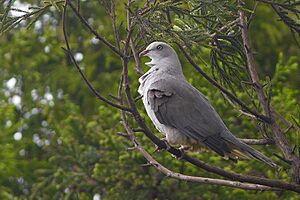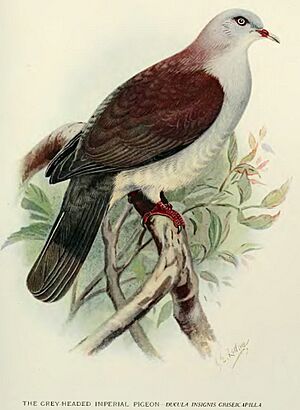Mountain imperial pigeon facts for kids
Quick facts for kids Mountain imperial pigeon |
|
|---|---|
 |
|
| Ducula badia insignis from Mahananda Wildlife Sanctuary, West Bengal, India | |
| Conservation status | |
| Scientific classification | |
| Genus: |
Ducula
|
| Species: |
badia
|
The mountain imperial pigeon is a large bird from the pigeon and dove family. It is also known as the maroon-backed imperial pigeon. These birds live across many parts of southeastern Asia.
Contents
About the Mountain Imperial Pigeon
The mountain imperial pigeon is the biggest pigeon in the areas where it lives. It can be about 43 to 51 centimeters (17 to 20 inches) long. This bird has a fairly long tail and wide, rounded wings. It flaps its wings slowly when it flies.
Its head, neck, and belly are a reddish-grey color. Its throat is white, which stands out. The upper parts of its body and wings are a brownish-maroon color. Sometimes, the upper body can look a bit duller. The underside of its wings is slate-grey. Its tail is blackish with a grey line across it. The maroon back and large size make this pigeon easy to spot.
What Does It Sound Like?
The mountain imperial pigeon makes a deep, booming sound. You can only hear this call if you are quite close to the bird.
Where Do They Live?
This pigeon lives in many countries across southeastern Asia. You can find them in Bangladesh, Bhutan, Brunei, Cambodia, China, India, Indonesia, Laos, Malaysia, Myanmar, Nepal, Thailand, and Vietnam.
They like to live in different kinds of forests. These include warm, wet lowland forests, mangrove forests near the sea, and wet mountain forests. You can find them from sea level up to about 2,550 meters (8,366 feet) high in the Himalayas. On the island of Sumatra, they live up to 2,200 meters (7,218 feet) high.
These birds mainly live in the foothills of mountains. They probably only have their babies above 500 meters (1,640 feet) in height. However, you might see groups of them feeding lower down. They usually prefer old, untouched forests. Where there are large areas of forest left, these pigeons are quite common.
How They Behave
Mountain imperial pigeons are usually found alone. But sometimes, you might see them in groups of up to 20 birds. This often happens when they are flying to their roosting spots or moving up and down mountains. They can be hard to see because they usually stay high up in the treetops. They also tend to fly quite high above the forest canopy.
Reproduction and Life Cycle
When a male pigeon wants to attract a mate, it puffs up its throat while singing. It also bows to the female. Then, the male bird flies straight up from its perch, about 6 to 8 meters (20 to 26 feet) into the air. After that, it glides back down with its wings and tail spread wide open.
In the northern parts of their home range, these pigeons breed from March to August. In southern India and southeast Asia, they breed from January to May. Their nest is usually in a fairly small tree, about 5 to 8 meters (16 to 26 feet) off the ground. The nest is a simple, flimsy platform. They usually lay one egg, but sometimes two. Both parents take turns sitting on the eggs to keep them warm. They only leave the nest if they feel very threatened.
What Do They Eat?
Mountain imperial pigeons eat fruits and berries. They especially like figs and nutmeg. They pick these foods and swallow them whole. Sometimes, they will go down to the ground to drink water. For example, in the mangrove forests of Borneo, hundreds of these pigeons have been seen drinking at once. In some areas, they might move to different heights in the mountains. They do this to find the best places to feed.



